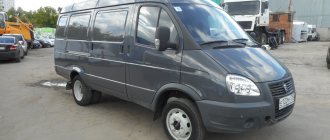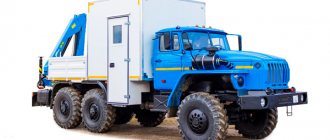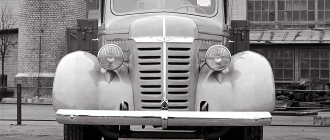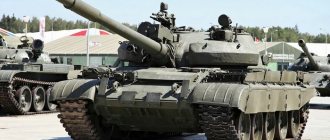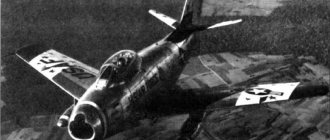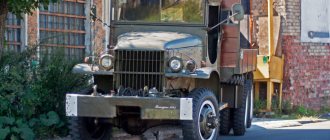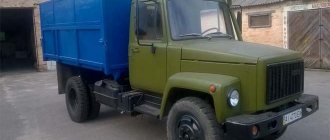Off-road trucks play an important role both in the national economy and in supplying the army. Such vehicles allow you to deliver cargo through any type of terrain, regardless of weather conditions. This aspect is especially appreciated when delivering to underdeveloped areas.
The main requirement for such trucks, in addition to good cross-country ability, is reliability and maintainability. Simple maintenance makes the machine in demand and, in conditions of urgent deliveries, often becomes a more important characteristic than fuel consumption.
ZIL-157 is a truck created almost simultaneously with the Ural-375. It has a lower carrying capacity, but has received recognition for its simplicity and reliability combined with good maneuverability. These qualities were especially valued in the army service.
Application of the ZIL-157 car
The initial purpose of the ZIL-157 is to meet the needs of the defense industry. The vehicle carried ammunition, various cargo and soldiers. Additional equipment with a winch made this type of transport convenient for evacuation of tracked and wheeled vehicles.
Over time, modifying the truck, the designers adapted it into the national economy:
Dump truck based on ZIL 157 in the national economy
- in construction;
- in various industries;
- in agriculture;
- in logging;
- on fish farms;
- in hunting grounds.
The ZIL-157 truck was actively in demand abroad. In Finland, this technique is still used in logging.
Thanks to its successful design, the car was successfully operated in all weather conditions. Adjusting the tire pressure made it possible to move at optimal speed on any soil - on arable land and off-road, in swampy areas and on sand dunes, as well as snow drifts.
New tires and automatic tire inflation system
In order to increase the off-road capability of the ZIL-157, the designers needed to develop completely new tires that could keep the truck moving even at reduced pressure. A special order was given to the tire factory, and within a short time new tires appeared with the following characteristics:
- High elasticity;
- Increased profile width;
- Reduced number of cord layers;
- Using special soft grades of rubber for the manufacture of inner layers of tires.
Although the decrease in tire pressure significantly limited the maximum speed of the vehicle (the technical characteristics of the ZIL-157 engine allowed it to reach speeds of up to 65 km/h), nevertheless, in terms of cross-country ability it still has no serial analogues. With the tire pressure as low as possible, the ZIL could move at speeds of up to 10 km/h. If the truck still got stuck, then the winch, which was installed on some modifications, could help it out.
Using the automatic tire inflation system, it was possible to set different tire pressures when driving on different types of soil:
- A pressure of 2.8 kg/cm2 is set for driving on paved roads and allows you to move at a maximum speed of up to 60 km/h;
- If the truck had to move through a field or forest, the tire pressure was reduced to 2 kg/cm2, and the speed had to be up to 30-40 km/h;
- If you had to move through sand or virgin soil after prolonged downpours, the pressure dropped to 1 kg/cm2. The speed did not exceed 20 km/h;
- It was necessary to move along swampy or snowy sections of the path with a pressure of 0.5 kg/cm2. The speed in this case did not exceed 10 km/h.
Naturally, the fuel consumption of a carburetor engine increased significantly while driving off-road. The aggressive “toothy” tread on ZIL-157 tires significantly reduced the risk of getting stuck and slipping.
The inflation compressor is capable of not only changing the pressure in the tire; in the event of a puncture, it allows the car to get to the repair site. Naturally, this option is only possible with a regular tire puncture. If a tire bursts, no compressor will save it.
Initially, the wheel inflation system was located on the outside of the wheels, but this was a rather unreliable place, since elements of the system could be damaged during operation of the ZIL-157. After the car was modernized in 1961, the inflation system was installed on the inside of the wheels. The next modernization, which took place in 1978, allowed the inflation system to increase tire pressure to 3.5 kg/cm2 when driving on paved roads. This allowed the maximum speed to be increased to 65 km/h.
The management of a centralized tire inflation system was very interesting and unusual for that time. It was controlled directly from the driver's seat and allowed tire pressure to be changed while driving.
Specifications
ZIL-157 has been popular for so long due to its technical parameters, the main ones of which are shown in the table.
Technical characteristics of the first models
| Characteristics | Unit change | Options |
| Max. declared speed | km/h | 65 |
| Load capacity on highway/dirt road | T | 4,5/2,5 |
| Fuel tank volume | l | 150 |
| Swivel outer radius | m | 12 |
| Max. lifting angle with load | hail | 28 |
| Ford depth | m | 0,65 |
In the first models, a worm steering mechanism with a 5-speed gearbox was used for control. In more modern cars, the steering wheel is equipped with a hydraulic booster. The transfer case is 2-speed and has a front axle clutch. The rear axles are parallel-separate.
Transfer case ZIL-157K
In improved models, each bridge was supplemented with a reinforced casing. The front suspension is a set of polyelliptic springs with hydrotelescoping shock absorbers, the rear suspension is a balancing type of springs.
The main braking system is a drum-type, pneumatic-driven type on all wheels. The parking brake is also a drum type, but has a mechanical drive to the transmission.
Rear axle ZIL-157
Reviews from owners and drivers
- ZIL-157 is my top Soviet all-terrain vehicle for fishing, household and cargo needs. My father had the exact same one, and then I bought myself a used model. This truck is notable primarily for the fact that it has three axles to improve cross-country ability. It took a long time to get used to the spartan cabin, because initially it was an army car with specific comfort. But in terms of cross-country ability, the car can be compared with the GAZ-66. I will note the huge ground clearance and toothy wheels, an openable windshield, a well-heated interior (due to the small wheelbase), and there is also a sunroof. The car easily overcomes arable land, it is not afraid of deep forest ruts - largely thanks to the wide running boards and fenders, as well as the deep tread of the tires. By the way, you can even sunbathe on these wide wings. So this is an excellent car for off-road recreation, including fishing and hunting. At 40 km/h, a 100-horsepower 5.6-liter engine consumes 35 liters.
- I have a ZIL-157 produced in 1975. I bought this rarity for 100 thousand rubles. Version with a 5.6 engine with a power of 110 hp. s., i.e. after restyling. I first became acquainted with this car when I served in the army. Of course, the machine is indispensable for these purposes. During the years of the USSR there were a lot of such army trucks. The car is good in terms of cross-country ability - it can iron out even the deepest ruts. In terms of cross-country ability, this ZIL is almost on par with the Ural. Decades have passed, but I still haven’t been able to forget the good old 157. I found a used copy on the secondary market in acceptable condition, with relatively low mileage. At full speed. I ride it on the harsh Siberian off-road. So, in my free time I use this roomy truck for hunting and fishing trips. The ZIL's cabin has been preserved in good condition, but the Spartan landing, of course, has not gone away. Of the significant disadvantages, I note the high fuel consumption of over 30 liters. The power steering is very heavy when you take off from a standstill. In motion, the steering wheel is already more or less light - a matter of habit. At first, such a heavy steering wheel hurt my hands. In general, ZIL-157 is a good option for impenetrable taiga. You can love this all-terrain vehicle or hate it. The machine is specific, it will be appreciated by an experienced user. I met ZIL-157 in 2010. Then I worked in a car repair shop, but by a happy coincidence, this SUV was gathering dust in one of the bays of our car service center. It was in a deplorable state, but our friendly team decided to restore it. After two years of fiddling with the selection of components, the old truck was at full speed, and we decided to test it off-road. The car was mostly in need of cosmetic repairs. In a muddy rut, the car behaves like a fish in water, including in swampy areas. This is truly the king of off-road driving with a 5.6 petrol engine producing 100 horsepower. The cabin is a bit cramped by modern standards, and the comfort is specific - you sit as if on a hard stool. However, the stove works efficiently. This machine can only be recommended to real business executives.
- I have a ZIL-157 produced in 1991. Equipped with various devices to improve cross-country ability, as well as more reliable operation in the winter season. For example, a pre-heater is installed, with which the 5.6 liter gasoline engine starts with half a turn. And yet we must admit that diesel is much better in terms of performance and economy. An additional gas tank is also installed to increase the range, because the fuel consumption of the 157th model is about 40 liters per 100 km. The cabin comfortably fits two passengers, but the seats inside are close to each other.
- I work on a 1982 ZIL. The car is unpretentious and quite reliable, despite its age. It is slow-moving and lacks power steering, and these are perhaps the main disadvantages, which are compensated by a wide range of advantages. The current mileage is 800 thousand km. I travel long distances, for example from St. Petersburg to Moscow, to Karelia. This car allows you to drive into beautiful and picturesque places where there is no one - only peace and tranquility. Repair and maintenance of the ZIL-157 costs a hefty sum, but the main costs go to oil and gasoline. The 5.6 liter engine consumes from 30 to 40 liters depending on the load.
- A passable and reliable truck with a high load capacity. It has high ground clearance and almost no body overhangs, which significantly increases the approach and departure angles. The spartan landing and hard seat seem to hint that the ZIL-157 is purely a workhorse for household needs. By modern standards, the engine has a hard time, and it is also very noisy, prone to overheating and oil burning. However, the six-liter diesel engine pulls regardless of the magnitude of the climb. Yes, unfortunately, there is no power steering, without which strong male hands are simply necessary - all hope is on them, and endurance will also come in handy. In summer, the engine often overheats, even at medium speeds. In ten years of operation I have never changed tires. Thick tires with deep tread have a long service life. Maximum gasoline consumption is 50 liters per 100 km.
- I work at a logging company and drive a Soviet SUV ZIL-157. Before that, I had a GAZ-53, then a ZIL-130 and 131. Somehow I didn’t have to plow on the 157th model, but this opportunity presented itself. The truck has been in active use for six months, and I can express positive impressions about it. You can put 9 cubic meters of wood in the back of a ZIL. At the same time, the wheels hardly slip – the car rushes along like a tank. The “tank feats” of the ZIL are impressive both in muddy ground and in deep snow. The car confidently overcomes sand and mud without a hint of slipping - largely thanks to the large and toothy wheels. The car is quite reliable, but it consumes a lot of gasoline and oil. The 5.6-liter engine produces only 110 horsepower, and fuel consumption is about 50 liters per 100 km.
- I do not recommend this car to anyone. Yes, it is impressive in terms of cross-country ability, but it consumes a lot of gasoline and it is still very difficult to find spare parts. The components seem to be there, but what condition they are in is another question. ZIL-157 is a huge machine with a high carrying capacity. Despite the specific driving position, mediocre visibility, noise and vibration, heavy steering wheel and clumsy wheels, this car is still a pleasure to drive – especially on harsh off-road conditions. Actually, ZIL is intended for these tasks. Gasoline consumption of 50 liters per 100 km is really quite a lot by modern standards, but this problem can be solved by installing gas equipment. You can also install a pre-heater and other additional accessories to improve ease of use. It also wouldn’t hurt to install an alarm with auto start, which will ensure uninterrupted starting of the heater using the remote control - this is very convenient in cold weather, when you don’t want to leave a warm room. Then you leave the room and enter a fully heated interior.
Description of the car engine
The first engines for the ZIL-157 were created taking into account the elimination of the shortcomings of the engines installed on the predecessor (ZIS-151). The improvements included such parameters as engine power, degree of overheating, trouble-free operation, gasoline consumption, etc. The modernization of the engine lasted until 1978.
The main type of engine of this car is carburetor, running on gasoline. But several models were released with a diesel engine, and it did not live up to expectations. The main disadvantage is the high level of vibration and shaking, leading to discomfort for the driver and passengers.
Start of production
The history of the creation of cars in the USSR has a difficult beginning. In the early 40s, when the outbreak of World War II was no longer in doubt, designers of the world's automobile factories were looking for a solution to improve army equipment. The USSR did not stand aside, because improving defense capability was a priority.
Then, thanks to the team of designers at the machine-building plant named after. Gorky, under the leadership of A. A. Lipgart, an event took place that turned the concept of automobile construction upside down. Namely, after all kinds of tests, they began producing trucks with constant velocity joints, thanks to which the front axle of a vehicle turned into a drive axle. Also, according to the theory of designers, all-wheel drive vehicles should have tires with special treads for all kinds of terrain conditions.
Cars must be produced with a special weight distribution along the axles. Further development of all-terrain vehicles ceased due to the outbreak of war. But this did not stop us from launching the production of the GAZ-63 truck, the only two-axle all-wheel drive SUV with unique cross-country ability.
Automobile plant named after Stalin in the pre-war years began producing two-axle ZIS-32 trucks, which at that time were distinguished by increased cross-country ability. And in the post-war period, the plant's designers began working on an analogue of the American Studebaker, using the ZIS-151 as a basis.
Since the Soviet truck performed well during the war, including as a carrier of the famous Katyusha launchers, the choice was obvious. But to the great disappointment of automobile creators, the ZIS-151 was much inferior to its American counterpart. This was confirmed during an off-road run in the spring of 1949.
Since the army placed its primary hopes on super-passable trucks, all errors and shortcomings had to be corrected in a short time. So in 1950, on the basis of the ZIS-151, the production of the BTR-152 armored personnel carriers was launched, but with single-pitch tires on all wheels with larger tires.
A project was also implemented to introduce a system for centralized control of air pressure in tires. This made it possible to significantly increase the truck’s cross-country ability on different types of terrain. But as the tire pressure decreased, the speed of the SUV also decreased.
Of course, having the ability to regulate tire pressure had more advantages.
When tire pressure decreases:
- Deformation increases and specific pressure on the ground decreases.
- The rut depth decreases.
- Energy costs for rutting are reduced.
- The soil resistance to wheel movement is reduced.
The driver, using a centralized system, could change the tire pressure even while driving. The military really liked this know-how, as it significantly increased the service life of the vehicle. Plus, if a tire was damaged, the movement of the SUV could not be interrupted, since the inflation system balanced the drop in air pressure in it.
Engine Specifications
Type of gasoline engine – 4-stroke. The block consists of 6 cylinders arranged in a row. Made of cast iron, and the cylinder head is made of aluminum. The block has a closed “jacket”. The coolant circulates through the block circuit.
Engine characteristics:
| Characteristics | Unit change | Options |
| Volume (before/after modernization) | l | 5,38/5,559 |
| Power at 2600 rpm (before/after) | l. With. | 104/110 |
| Torque | H/m | 334 |
| Cylinder/piston diameter | mm | 101,6/100 |
| Piston stroke | mm | 114,3 |
| Average fuel consumption | l/100 m | 42 |
| Filling tank volume | l | 150 |
The table shows the parameters of the base car. Thanks to improvements in subsequent models of the crankshaft, oil pump, pump seals, and the introduction of closed crankcase ventilation, many characteristics of the ZIL-157 engine were improved.
In the latest models, it has become possible to install an additional tank with a capacity of 65 liters. This makes it possible to cover a distance of more than 500 km on one gas station.
Despite the simplicity of the design and unpretentiousness, the engine is trouble-free and reliable in operation. Even after inactivity, it starts quickly, but is sensitive to low temperatures, so in winter it requires special care.
Over time, the thermostat on the engine was modified, but the cars continued to be equipped with insulating covers until the last moment. The modifications also eliminated problems with motor overheating.
Price
ZIL 157 can be purchased at the present time. Depending on the technical condition, the cost of the car can vary from 50 thousand to 200 thousand rubles.
Thus, models in the price range from 50 thousand to 80 thousand rubles are either not in working condition, or in very close to it.
At prices ranging from 150 thousand to 200 thousand rubles, you can purchase a fully operational truck. But often they are bought not to perform any work, but for complete restoration. This is due to high fuel consumption, especially these days.
Cabin structure
The original cabin of the ZIL-157 was uncomfortable for both the 2 passengers and the driver. Over time, thanks to telescopic shock absorbers, the designers made the steering easier, and the driver began to exert less physical effort when driving. By introducing an additional radiator with a fan-impeller, it became possible to heat the cabin and the front window.
Salon ZIL-157
Equipping the interior with a dashboard made it possible to control the car’s systems: axle gears, turning off headlights, lubrication and brake pneumatic pressure gauges, foot start, winch levers, etc.
Modifications of the ZIL-157 truck
During the entire time that ZIL-157 rolled out of the container at the Likhachev plant, the cars were constantly modernized. Basic models are characterized by the presence of a tire pressure system, single-pitch tires, split wheels, foot-operated starter, and a winch mounted on extended brackets.
The main stages of truck modernization are shown in the table.
Modifications of ZIL-157:
| Letter index | Peculiarities |
| B | Not equipped with a tire pressure control system |
| IN | Used as tractors |
| G | Equipped with electrical sealed, shielded electrical equipment. The cathode terminal of the battery was connected to the car body |
| TO | Second generation of base cars with a more powerful engine (109 hp). It has a synchronized gearbox and another rear view mirror. These models began to use winches on extended brackets |
| KG | The second basic option is supplemented with electrical sealed equipment with a screen |
| KD | Representative of the 3rd generation, supplemented by an electric starter and a new on-board platform. Has improved motor characteristics and increased load capacity |
| E | The ZIL-157 car was produced exclusively for export to countries located in mid-latitudes |
| YU | Export version for tropical conditions. It is lightweight due to the absence of an engine pre-heater and interior heating |
In addition to the basic models, other options were used: special vehicles for the army, workshops on wheels, vehicles for electrical supply, fire trucks.
Basic car modifications
This model is available in different modifications, each of which is characterized by its own individual characteristics. Among the most popular are:
- ZIL-157V – truck tractor;
- ZIL-157Yu – tropical modification;
- ZIL-157E – export modification;
- ZIL-157KD - basic version since 1978;
- ZIL-157G – model with shielded equipment;
- ZIL-157E is a special version, equipped with two gas tanks with a total capacity of 300 liters.
ZIL brand 157 is a unique base of various forms of modifications in all respects, which are equipped with standard, as well as strictly specialized purposes. Truck models differ in their configuration features; the characteristics of the ZIL 157 and its modifications may be different. There is a ZIL 157 model with tanks of different volumes, with vans, repair shops, and ladders. Cars with onboard body elements are very popular.
Truck tractor
